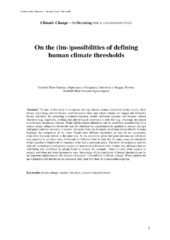| dc.description.abstract | The aim of this study is to explore the way climate creates thresholds within society. Both human physiology and the human mind determine when and where climate can trigger and influence human activities. By presenting a stimulus-response model, deliberate weather- and climate- related decisions (e.g. migration, clothing) and physiological responses in daily life (e.g. sweating) are placed in a broader theoretical context. While physiological thresholds can be described quantitatively to a certain extent, subjective thresholds may be illustrated in a predominantly qualitative manner through surrogates (surveys on wants or needs). Examples from the literature on climate thresholds for humans highlight the complexity of the issue: People have different thresholds, as they do not necessarily respond to the same stimuli in the same way. At the same time, given the same stimulus, an individual may perceive it, and thus react, differently at different times in their life. In many cases, the threshold rather specifies a bandwidth or transition zone than a particular point. The level of acceptance and the cultural, technological and genetic aspects of adaptation will decide how climate may influence human well-being and contribute in setting limits to society, for example where to live, what impacts to expect, and when and what decisions to take. Knowledge of the complexity of human thresholds can be an important supplement to the analysis of peoples’ vulnerability to climate change. When populations are vulnerable and thresholds are exceeded, only then will there be a measurable response. | en_US |
